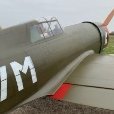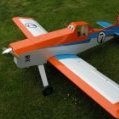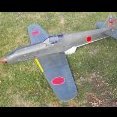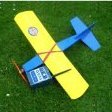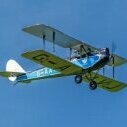Leaderboard
Popular Content
Showing content with the highest reputation on 27/10/22 in all areas
-
Chris golds TB-3 Scratch built from plans. A first for me, to build a 4-engine plane. Some scale details to add, eight 3-d printed exhausts, air coolers and streamlining for the landing gear. The model is slightly modified from a bomber to an arctic explorer. The original plans incorporated some foam which i changed to balsa. I changed the open cockpit to a closed one. With references from photographs. Flies well with lots of presence Anders11 points
-
I’m troubled by the recent posts, and I feel I the urge to comment. The saddest reflection on this hobby Jon, is people who can’t just let others have fun in the way they want. Who cares??, they are smiling, others are smiling, some (you) are not.. that’s life…Words such as ridiculous and stupid describe some peoples opinions, not the way a model flys!!!.. It’s a hobby and people do it for fun. There will be no one left on this forum soon.5 points
-
The priority of failsafe is for the model to descend quickly without endangering other airspace users not to land the model without it being damaged.4 points
-
Well, there's paint on it. I can say that. Not my finest work. As long as I can keep anyone with DVLA standard eyesight to a respectful distance, of, maybe half a mile, it looks fine...3 points
-
On her legs for the first time whilst finalising the wing dowels and fixing bolts. A crucial stage for any build and in this instance required several hours of measuring, fine fettling and more measurements before I was satisfied. Also used the opportunity to fit the wing saddle ply fillet bases.3 points
-
Four bowlers were out on the Green practicing. As one of them was about to bowl, they saw a funeral procession go by. Instead of bowling, the bowler removed his cap and placed it on his chest until the funeral had passed. At this point, one of the others said, "You know, that was the most touching thing I've ever seen." And the bowler answers, "Well, I was married to her for 20 years. . It was the least I could do." .3 points
-
Gents a long running thread is being disrupted and bringing complaints and PMs. I care not at all how any person chooses to enjoy their hobby, nor if people chat about flying in a scale like manner, or not. What counts on here is behaving in a civil like manner and respecting others may hold differing views, curb the language likely to offend, it adds nothing to the point.2 points
-
Thank you all. I have just got back in, and scanned all your kind replies. Unplugged the ESC, with Rx battery connected, switched on Tranny, rolled the throttle trim all the way down. Plugged the ESC back in, expecting to have to re-bind, or hear beep beep, but all was quiet! Tried ailerons and elevator- working fine, turned up the throttle on the tranny (no prop attached!), and throttle works perfectly! Many thanks again. Once again, the forum has saved me! Now, I'l take the model out and see if it flies!2 points
-
A steady beep-beep is often an indication that the throttle was not at zero when the ESC was activated (battery plugged in / switched on).2 points
-
Fly, recharge. . . Fly, recharge. . Repeat often until the lipos go beyond their useful life. Dispose of moody lipos and buy new ones. . . Repeat as above. Some lipos last longer than others. . Such is life. Personally, my limit on electric flight is 4s. . After that, it just gets stupidly expensive. .2 points
-
Hi Ray. It is fairly common knowledge on the forum that I used to manufacture the Airsail kits in this country (they were originally from New Zealand) I will P.M.you with my contact details and you can let me know if you want a copy of the manual (it is not a couple of A4 sheets !)1 point
-
JD8. I have the 120 4c which is a bored 90. Flew it for years in a H9 pulse 60 on SMC 5/15+2 castor fuel and it performed very well. The model eventually fell apart and the 120 is currently sleeping under the bed. I also have the 53 in my Tomahawk, a 155 in a pulse 125 and an 80 (rare beast) in a box also waiting for an assignment. My 155 was a dog. Ebay job, 'runs perfect' etc. I have replaced most of the engine and its got a laser carb on it. Runs very well on the 5/15 fuel but i need to have a word with it as it destroys every exhaust i fit! Fin, a super 60 with that engine would be sedate but lovely. One day i will build one, i just need to buy one of those old hangars they used for airships as my list of models to build is quite long and i need somewhere to put them1 point
-
I did what you are suggesting, made templates from Frisk Film (a tacky, translucent film), from which some of the lozenges were cut using a sharp knife. The templates were (one at a time) laid onto the model and the lozenges drawn through using a pencil. Once the whole area was covered, they were painted, one colour at a time, using Humbrol enamel mixed to give the right shades. It was necessary to make three separate templates; that was the minimum that would be required to avoid cutting out any two adjacent lozenges. Mine was for a Fokker DVII (Flair kit) and my covering was Solartex, but it would work the same way onto tissue. The first step was to enlarge some lozenge pattern downloaded from the internet to the correct scale, this was then used to mark out the Frisk Film templates. I made the templates long enough and wide enough to get a couple of 'repeats' working in each direction, it is then just repositioned over the already marked lozenge working outwards on the wing span. On the full-size, the covering linen was joined every third rib, so I simulated the joins in my pattern. Each section was also reversed in relation to the previous one, though that might not have been the case on all full-size. Here are some photos of the process. Cutting out non-adjoining lozenges from printed paper pattern. Transferred onto Frisk Film and cut out using a sharp knife. Pattern transferred onto wing. Note simulated join in the lozenge pattern on third rib in from tip. Painting partially completed. It does take a while painting in all of the lozenges but the effect is good once finished. Brian.1 point
-
One of my clubmates found a haberdashery which produced a lozenge printed fabric at approximately the right scale and was able to finish his magnificent Magnatilla in this fabric. She looks fantastic.1 point
-
They didn't paint the lozenge patterns, they were printed on metre wide cover material. This would have been no more difficult than normal fabric printing for curtains etc so peacetime machinery & expertise/labour would have been in place anyway. Erf, have a look here it's a plastic kits site that probably has done all the research & come up with a reasonably confident representation of the colours.1 point
-
1 point
-
IR and how well the cells balance is far more instructive than a low C discharge IMO. I have seen plenty of lipos that "pass" that kind of check, but measure their IR and individual cell voltages off charge and you can see a different story that will manifest pretty clearly in the air in terms of performance...1 point
-
You just have to admire Chris Golds' extensive back catalogue of plans of unusual planes. That looks a treat.1 point
-
1 point
-
I can find no mention of endangering a flight in CAP722, perhaps if someone can then that would supercede Article 23 from the ANO2016 which specifically excludes small unmanned aerial vehicles from Article 240 (endangering the safety of an aircraft) of ANO2016. .. it just goes to show what a mess the whole thing is. I wholeheartedly agree. IF educating the police officers is the goal then I feel it is to be applauded. There appears to be far too many officers making stuff up 'on the fly' trying to impose their will on someone legitimately going about their legal business. This seems to come from their training and is a deplorable situation. Ask yourself how would you like some copper turning up at your flying site insisting you stop flying and, indeed, arresting you for a false law they have just made up on the spot?....because that is what happens to some of these auditors. Incidentally, the following civil case these people occasionally bring against the officers and the police force for wrongdoing are settled out of public money....your taxes. You would think by now every police officer in the country would have been instructed in what they can, and cannot do, in relation to these auditors, but apparently not.1 point
-
Good oh, John. Again the BMFA have a resource in that they publish a Battery Safety Booklet, original published in 2014 & updated 2020. I'm attaching it as a .pdf but for info it's on the BMFA Website: BMFA Homepage>More>Downloads>Handbook, Guidance & Codes of Practice>Battery Safety Booklet. LinkBattery Safety Booklet - June 2014.pdf1 point
-
1 point
-
The other thing to do Don, if your charger will allow it, is to charge to 95% rather than 100%. It is both quicker and extends the life of the LiPo all other things being equal. Depending on your charger, "Fast Charge" may mean only charging to 95%. Charging might mean charging to 100%. If you use a voltage checker once your LiPos are off charge you should be able to see the difference between 100% and 95% charge. If you have to resort to balancing the LiPo once it is off charger than consider buying a better charger that will sort out cell imbalance until one cell starts to go duff of course. Since chargers last a good deal longer than LiPos, having a good balancing charger is worth it if you can extend your LiPo life. As Brian Cooper says, some LiPos last longer than others. I've got a bog standard Turnigy Blue pack (2 x 5S that I use in 10S configuration for flying) and that pack has reached 160 cycles and is just beginning to not perform in the schedule I fly. These packs are charged to 95% capacity and end at 3.6 -3.7 V per cell after flight - shows as 14% remaining on my Voltage checker. When I charge them, they generally take around 3200 - 3500 mAh which by my calculation means that I've used between 70% - 74% of capacity. That gives 8 mins of flying a quite testing competition aerobatic schedule.1 point
-
It could be worthwhile aquatinting yourself with the specific section of the BMFA Handbook relating to Electric Flight for advice on these topics. Link1 point
-
As this has become how I read it a personal attack on what I do and the way I fly I won’t be contributing to this forum anymore, Sick to the teeth because of the underlying on line abuse because I won’t conform to others views1 point
-
1 point
-
Don your regime looks good to me, especially if you are balance charging. The only pro to a Lipo fast charge is a shorter charge time, but you run the risk of increased heat build-up and battery degradation. If you have a battery which the charger is struggling to get the cells in balance, try charging it at a lower charge rate, say 0.3 amps. The way the balancing works on charger is by diverting a small amount of current (typically 100 to 200 ma) around the high cells while charging, if you are charging at a high rate it doesn't give time for the low cells to catch up before the high cells are fully charged.1 point
-
These miscreants can't really be described as "model flyers" or even as "enthusiasts". They are merely "passing through". Their irresponsible behaviour is designed to grab attention..... or will give them something to brag about at the pub. At best, they can be described as "cheeky". Ultimately, their actions will just result in further restrictions. There has never been a world shortage of idiots. . . They walk among us.1 point
-
These so called " auditors " have no moral compass and waste the time of authorities to gain followers on youtube. It is just another money making scheme.1 point
-
Straight advice, don’t use eBay for basic stuff like batteries, low end receivers, servos. too many of the batteries are cheap, and will fail early. Too many of the servos are straight fakes. Too many of the Spektrum receivers are fakes. somewill say, they are fake but OK. I say made by liars who don’t even admit the made it. Be aware of the lie vendors push, made by Spectrum suppliers out of left over parts at the end of a production run. Use a known source. Alternativley, Orange or Lemon do Spectrum clones. I have good service from Orange. Not used Lemon, but seem to have a good reputation.1 point
-
Don A 1C charge rate is considered safe as it restricts heat build up during the charge which LiPo don't like as it shortens their life. A modest heat build up during discharge is less of a problem but excessive heat will shorten their life. Some very low resistance batteries (60C+ max discharge rate) can be charged at up to 5C but it is worth noting that the internal resistance of all LiPo increases with use so at some point in its life a 5c charge may become an additional risk. A regular balance charge to ensure all the cells are bought up to exactly the same voltage (4.20V). It takes a bit longer to do but it will improve the LiPo life.1 point
-
Of course! The only 'qualifying requirement' is to be a member of the forum. Whether is's new faces, or old ones rejoining, I'm always happy to see more entrants in our league table. So come on back!1 point
-
To clarify, the ESC has no idea whether the transmitter is on or off. All it knows is whether there is a valid throttle channel pulse from the receiver, and that depends entirely on the receiver configuration. Some systems allow you to set the failsafe positions from the transmitter (mine does), some are set via the receiver FS button -but failsafe itself is entirely a receiver function. Consequently the ESCs response to the transmitter being switched off is determined only by the receiver. Receivers without failsafe generally cease outputting servo pulses on loss of RF signal, which will stop the ESC, not through loss of RF but through the receiver ceasing its throttle channel pulse. With a failsafe receiver, the ESC NEVER sees a loss of throttle signal and has no clue whether the transmitter is on, off or has failed 👍 Cheers Phil1 point
-
You set the failsafe on the S8R just as you would with any other Frsky gear be it IC or electric. However, it is very unlikely you will ever get a flyaway, one because the range is very good anyway, and secondly because you will get audible warnings that the signal strength is low long before the receiver goes into failsafe. You cannot set the failsafe to switch on stabilisation, indeed there should be no need if the plane is well set up in the first place. Its worth setting the motor to 0% failsafe and add a little rudder % so that the plane will turn and either spiral down or come back into range, though I don't know how effective this would be though as I've never had a plane go out of range.1 point
-
I’ve used Robarts for flap hinges on quite a few models, here is the way that I retro fitted flaps to my Sig Rascal1 point
-
It is my Feugrey, a French aerobatic aircraft. PDF attached. It was an RCM&E Plan From somewhere betwen 2008 and 2011. Probably in the Sarik files if you check Feugrey.pdf1 point
-
Shorts Sperrin from the Chris Golds plan, 74" wingspan. 4 x 55mm Vasa fans, running on 6S, 53,000rpm producing over 800g of thrust each and using 450W. Successfully maidened today. Will take off from grass runway (not bowling green smooth) but would be better of tarmac. Will happily cruise around on 150W per fan so 9 minutes flights are possible. The Sperrin was designed late 40s early 50s as a fallback in case the Vulcan, Valiant & Victor, all revolutionary designs failed to live up to expectations. The Sperrin was very much a conventional design, rounded rectangular fuselage, basic wing with the unusual (in hindsight) stacked engines rather than side by side. 2 prototypes were built and ended up being used as test beds for other engines and for flight research.1 point
-
A couple of little jobs to do before I tackle the covering, hinges for the ailerons and flaps. I decided to use 'furry' mylar hinges for the ailerons, just like the original had and was able to cut slots close to the original hinge positions. But for the flaps I wanted there to be a 'slot' between the flaps and wing when they are in the down position. I was going to 3D print some stand off hinges for this but decided to use Robart instead. In order for these to work as I wanted they had to be positioned back from the flap / wing join so that their hinge point sits below that joint line. They also need to be fitted into holes which are set at an angle (the pictures that follow make this clearer!). To make sure that I drilled the holes in the correct position I fashioned a drill guide out of some scrap plywood, and drilled several guides so that I could chose which one was going to be the best. The guide is held against the wing false TE and then against the flap LE With a drill stop in place to prevent me going too far! This gives the required set back hole The test pieces with Robarts fitted And having then drilled the holes in the flap and wing I dry fitted the assembly With the flaps deployed That only left the covering to be done which took an incredible amount of time, in fact I've only completed one wing and the other won't be finished for a few days as I realised that I won't have enough white (a 5m roll is not enough for both wings!). Still, there are plenty of other jobs that need doing so I won't be wasting time. The one wing (the 'bad' one) covered.1 point



